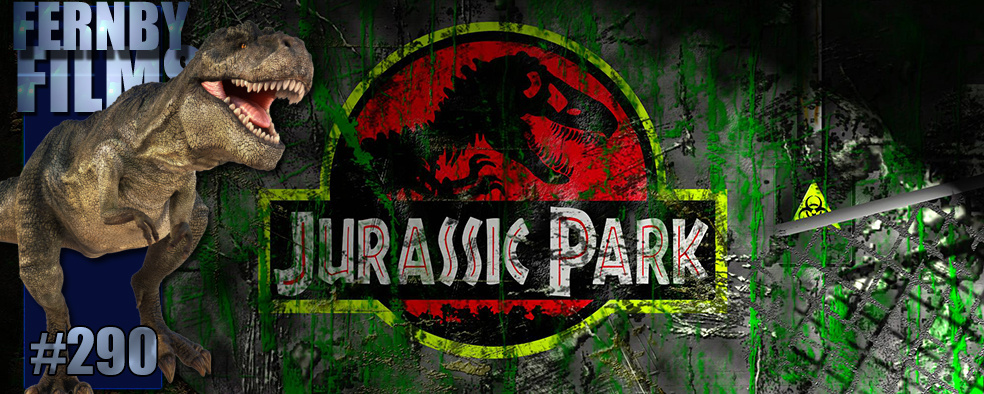Movie Review – Jurassic Park
Critic-proof concept based upon Michael Crichton’s novel, Spielberg ratchets up the terror and tension using state of the art digital animation effects, and wiley film-making techniques, to ensure Jurassic Park became one of the highest grossing films of all time. Astounding effects (for their time) still hold up, even though by today’s standards they are few and far between; it’s the imaginative use of them that really heightens the terror you feel while watching this film.
– Summary –
Director : Steven Spielberg
Cast : Sam Niell, Laura Dern, Jeff Goldblum, Richard Attenborough, Wayne Knight, Bob Peck, Samuel L Jackson, Arianna Richards, Joseph Mazello.
Year of Release : 1993
Length : 90 minutes
Synopsis: When scientists develop a way of cloning dinosaurs from DNA left over from the Jurassic period, they set up a theme park with the thought of making millions. But when a series of events leaves the enclosed dinosaurs free to roam the park and chase people, including the very people brought to the island to vet the idea as sound and safe, things take a dramatic turn for the worst, and our small group of survivors must use their ingenuity to escape certain death.
Review : Critic-proof concept based upon Michael Crighton’s novel, Spielberg ratchets up the terror and tension using state of the art digital animation effects, and wiley film-making techniques, to ensure Jurassic Park became one of the highest grossing films of all time. Astounding effects (for their time) still hold up, even though by today’s standards they are few and far between; it’s the imaginative use of them that really heightens the terror you feel while watching this film.
********************
Stunning, frightening, spectacular film success from legendary director Steven Spielberg, unleashing realistic digital dinosaurs upon the cinema-going public in Jurassic Park. Released in 1993, Spielberg effectively launched the field of digital animation in motion pictures with this single film, a film which still holds up under scrutiny today as a roller-coaster ride of thrills, spills, and amazing action as only Spielberg can provide. Today, we take a look back fondly at a time when digital animation was in it’s infancy, an expensive, prohibitive way to to bring fantastical elements of a story to life. Jurassic Park spawned two sequels, The Lost World, and Jurassic Park III, which all added to the franchise set in motion with this one, pivotal film. Jurassic Park also gave us our first theatrical taste of the new sound system known as dts, or Digital Theatre Systems, a competitor to Dolby’s own 5.1 discrete channel soundtrack format, which itself premiered theatrically a year earlier with Batman Returns. Yes, 1993 was a big year for Spielberg: that same year he also gave us Schindler’s List, the Oscar winning Holocaust film which finally gave the master director a golden statuette to take home.
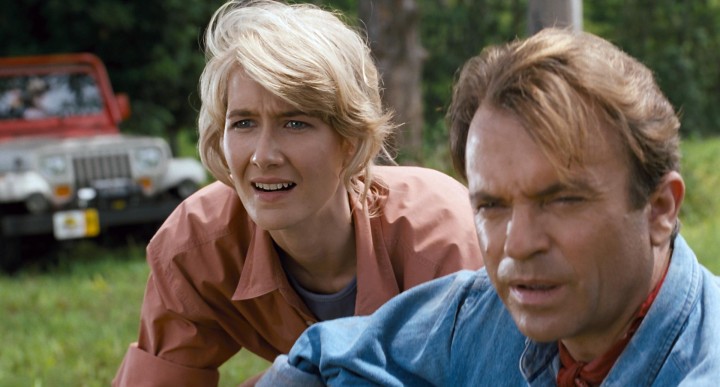 Jurassic Park told the story of a group of scientists and anthropologists who are whisked to an uncharted island to inspect a new theme park; only in this theme park, the attractions are living, breathing dinosaurs, born from genetic manipulation and clone research. Ostensibly a theme park, the Jurassic Park complex also served as a research laboratory to further man’s understanding of dinosaurs, since the giant creatures all died out millions of years prior. However, when the power to the island is lost due to industrial sabotage and the onset of a tropical storm, the dinosaurs escape from their enclosures and run amok in the park, chasing the island’s inhabitants throughout the film. Starring a stellar cast including Laura Dern and Sam Neil as husband and wife palaeontologists, Jeff Goldblum as a renegade Chaotician, and Richard Attenborough as the multi-millionaire behind it all, John Hammond. Also along for the ride were youngsters Lex and Tim (Ariana Richards and Joseph Mazello respectively), grandchildren of Hammond and the key demographic for the soon-to-opened park. Throw in Wayne Knight as a saboteur, Samuel L Jackson as a park employee, and the late Bob Peck as a big-game hunter who controls the animals during feeding time, and provides park security.
Jurassic Park told the story of a group of scientists and anthropologists who are whisked to an uncharted island to inspect a new theme park; only in this theme park, the attractions are living, breathing dinosaurs, born from genetic manipulation and clone research. Ostensibly a theme park, the Jurassic Park complex also served as a research laboratory to further man’s understanding of dinosaurs, since the giant creatures all died out millions of years prior. However, when the power to the island is lost due to industrial sabotage and the onset of a tropical storm, the dinosaurs escape from their enclosures and run amok in the park, chasing the island’s inhabitants throughout the film. Starring a stellar cast including Laura Dern and Sam Neil as husband and wife palaeontologists, Jeff Goldblum as a renegade Chaotician, and Richard Attenborough as the multi-millionaire behind it all, John Hammond. Also along for the ride were youngsters Lex and Tim (Ariana Richards and Joseph Mazello respectively), grandchildren of Hammond and the key demographic for the soon-to-opened park. Throw in Wayne Knight as a saboteur, Samuel L Jackson as a park employee, and the late Bob Peck as a big-game hunter who controls the animals during feeding time, and provides park security.
The film begins with a bang, as Peck’s Robert Muldoon is seen bringing a wild, uncontrollable beast into the park ground, before it tries to escape and kills a worker. We are offered only a tantalising glimpse of something unearthly here, an eye and the roaring sound of a creature unlike any we’ve heard before. It whets our appetite for what’s to come. Then, we are off for some character introductions and a whole slew of exposition, before the dinosaurs come out to play. Alan Grant and his research partner Ellie Satler are met by businessman John Hammond and given an extraordinary proposal: to look around his newly built theme park (without knowing what it’s about) in return for a significant grant to fund their fossil research. Of course, with such a carrot dangling, who would say no? So, they’re whisked off to Isla Nublar, off the coast of Costa Rica, where they meet mathematician Ian Malcolm, an eccentric playboy who delights in making a situation awkward, it seems. He instantly eyes off Ellie as a potential conquest. They also meet Hammonds grandchildren, Lex and Tim, as well as Hammonds negative lawyer Donald (Martin Ferrero), all of whom are equally unaware of the parks purpose. Hammond, giggling like a child, introduces them to the park, by showing them some wild, plant eating Brachiosauri as they travel to the parks headquarters. This moment, an indelible one in the film, and in audiences minds, first gives us a chance to examine just how cool and realistic Spielberg’s digital dinos were going to be.
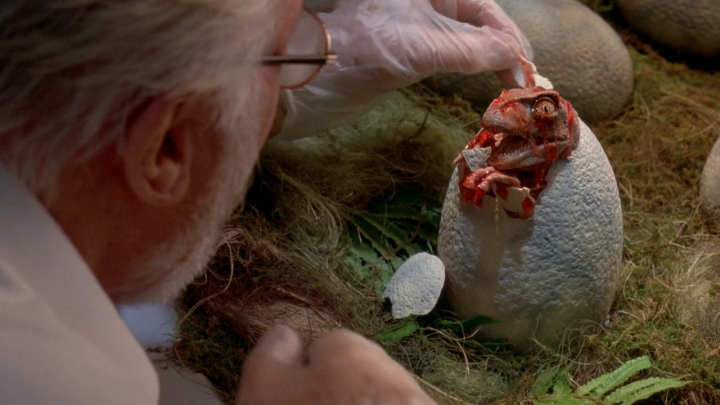 With everybody ensconced in the Jurassic Park headquarters, chowing down on a lavish lunch (“spared no expense”, declares Hammond at almost every turn in his bid to impress his visitors) and being given a lesson in dinosaur and palaeontology, which enlightens us as viewers as well, after a brief respite, our gang are promptly put into automated vehicles and driven along a set path to each pen housing a different dinosaur species. And it’s here that things start to go wrong. As they pass each pen, the dinosaurs are nowhere to be seen. Gradually, excitement gives way to boredom, but not before the power cuts out and the group are free to explore the Park on their own. Which isn’t a good idea. With industrial sabotage by Wayne Knights character giving the security at the park a massive slap in the head, the resident dinosaurs are also free to roam, in particular the massive Tyrannosaurus Rex (shortened in this film to T-Rex, a synonym which has since stuck in popular culture as the definitive term by which the animal is known) and the fast, intelligent and extremely dangerous raptors, man-sized dinosaurs capable of rending limbs and chomping bones, an enemy not to be trifled with. And so begins a desperate chase through the park to try and escape, dinosaurs chomping at their heels.
With everybody ensconced in the Jurassic Park headquarters, chowing down on a lavish lunch (“spared no expense”, declares Hammond at almost every turn in his bid to impress his visitors) and being given a lesson in dinosaur and palaeontology, which enlightens us as viewers as well, after a brief respite, our gang are promptly put into automated vehicles and driven along a set path to each pen housing a different dinosaur species. And it’s here that things start to go wrong. As they pass each pen, the dinosaurs are nowhere to be seen. Gradually, excitement gives way to boredom, but not before the power cuts out and the group are free to explore the Park on their own. Which isn’t a good idea. With industrial sabotage by Wayne Knights character giving the security at the park a massive slap in the head, the resident dinosaurs are also free to roam, in particular the massive Tyrannosaurus Rex (shortened in this film to T-Rex, a synonym which has since stuck in popular culture as the definitive term by which the animal is known) and the fast, intelligent and extremely dangerous raptors, man-sized dinosaurs capable of rending limbs and chomping bones, an enemy not to be trifled with. And so begins a desperate chase through the park to try and escape, dinosaurs chomping at their heels.
It’s hard to know where to begin with a review of Jurassic Park. The story, cobbled into a screenplay by David Koepp, based upon Michael Crightons novel, is fairly simplistic, putting a variety of people into a variety of dangerous situations involving free-range dinosaurs. The characters are pretty one-dimensional, it has to be said, yet all are equally valid in terms of what they bring to the film. The scientific experts, the security expert, the technology expert, the children (experts in being kids, no doubt) and even the benevolent philanthropist; all these characters are facets of a humanity who would be fascinated with being able to bring back the dinosaurs. Thus, we as viewers can identify with some, all, or a few of them, which brings us into the story on an emotional level. Yet none of the characters evolve, as such, with the possible exception of Hammond himself, who realises by films end that perhaps playing God isn’t a safe business move. The kids are cute and charming, of course, in typical Spielberg fashion they remain alternately assertive and bewildered, a concoction of wide-eyed innocence and near-adult perception that stand them in good stead for the terror to come. Spielberg’s film kids have always had an inner strength to them, regardless of situation, and while I tend to think the man should perhaps open himself up to other options, for Jurassic Park, both Richards and Mazello play their roles perfectly.
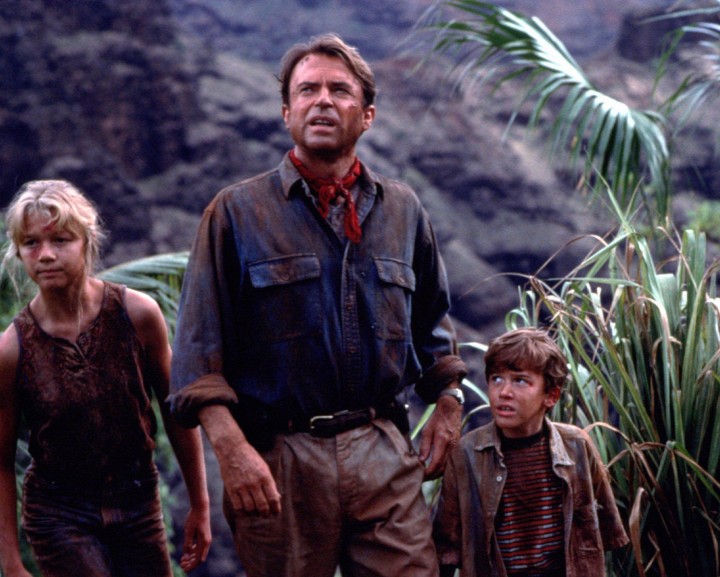 The film is almost Hitchcockian in its build-up. The slow burn tension gathers pace from the shadowy opening scene, in which a worker is killed by an unseen dino. From there, the explanatory stuff is given out at a fairly rapid clip, setting up all you need to know about dinos to survive the film and understand what’s going on. Then, when the power goes out, Spielberg unleashes his dino fury at full force, like a theme park ride that’s only slightly out of control. Death stalks out heroes at every turn, as they make their way through the park, dodging everything from raptors to electrified fences. It’s a perfect release to a stunning opening half-hour, in which we get to know our characters and the scenario they find themselves in. Koepp ratchets up the tension with the humans being slowly herded into smaller and smaller areas of the compound, resulting in a heightening of tension throughout the films final act. The intelligence of the raptors is borne out in a thrilling, breathless sequence with the kids in the kitchen, being pursued by a trio of the deadly animals. They learn from their hunt; as one character states simply: “they remember.”
The film is almost Hitchcockian in its build-up. The slow burn tension gathers pace from the shadowy opening scene, in which a worker is killed by an unseen dino. From there, the explanatory stuff is given out at a fairly rapid clip, setting up all you need to know about dinos to survive the film and understand what’s going on. Then, when the power goes out, Spielberg unleashes his dino fury at full force, like a theme park ride that’s only slightly out of control. Death stalks out heroes at every turn, as they make their way through the park, dodging everything from raptors to electrified fences. It’s a perfect release to a stunning opening half-hour, in which we get to know our characters and the scenario they find themselves in. Koepp ratchets up the tension with the humans being slowly herded into smaller and smaller areas of the compound, resulting in a heightening of tension throughout the films final act. The intelligence of the raptors is borne out in a thrilling, breathless sequence with the kids in the kitchen, being pursued by a trio of the deadly animals. They learn from their hunt; as one character states simply: “they remember.”
In retrospect, Jurassic Park only has about ten minutes of actual screen time with fully realised digital dinosaurs. Where Spielberg works well to overcome this deficiency (by today’s standards, most films have more effects in their opening credits!) is by limiting his use of the digital effects to their most powerful moments. The rest of the time, the dinosaurs are all either animatronic automation or puppets. This seamless blend of digital and real is made possible by using a lot of shadows, rain and mist, all obscuring any potential audience nitpicking over what’s real and what’s not. Even now, nearly 2 decades since the film came out, the effects hold up under scrutiny. And Spielbergs canny use of them, again a very Hitchcockian thing to do, serves the story more-so than the George Lucas school of film-making, which has everything out in the open with little left to imagine. And it’s here that Spielberg is among the very best directors working today. He is prepared to let the audience imagine things for themselves. Because we don’t always see the entire creature, we imagine things in the bits we can’t see. An eye peeking out here. A claw coming down there. The rest our minds fill in, and often what we can imagine is a lot worse than the reality. Spielberg taps into that, and Jurassic Park is infinitely more thrilling because of it.
If I can get a little technical for a moment, it’s interesting to note that Jurassic Park was the first film to be released theatrically with the newfangled dts Digital Sound, a multi-track digital soundtrack capable of full range audio to all 5 main channels in the cinema. The clarity and lack of compression on a dts soundtrack, as opposed to the competing format in Dolby Digital, enabled Spielberg to mix his film with a precision and definition that had, at the time, never before been heard. The resulting soundtrack is still audible on the dts track version of the DVD, and at the time of this review, is unavailable on BluRay. The sound mix on Jurassic Park remains one of the defining moments in cinema.
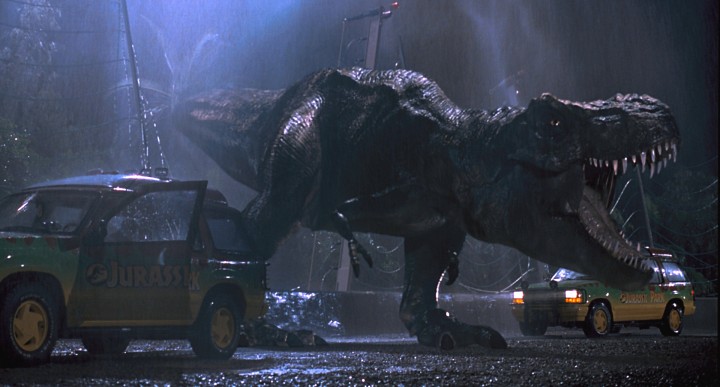 Spielberg has, I think, had a fairly spotty career since the golden year of ’93. Since then, he’s polarised audiences with goodies like Saving Private Ryan, War Of The Worlds, and Minority Report. However, he’s also been blessed with some commercial speed bumps, like AI and Munich, to name a couple. And don’t get me started on the fourth Indiana Jones flick. With Jurassic Park, we get vintage Spielberg at his peak: his use of lighting, camera angles and editing are first class, and he can shoot a scene like nobody’s business. Take into consideration the lengthy T-Rex attack on the upturned Jeep with Grant, Lexie and Tim trapped between a giant cement cliff and the rampaging animal. The very ground shakes as the T-Rex stomps into view, it’s massive jaws chomping on that poor goat. Grass shatters, metal buckles and splinters, the beasts hot breath swishing Alan’s hat from his head in one of the films most iconic moments. Spielberg uses very few shots to generate his tension: while a less accomplished director might resort to a hundred cuts a minute here, you can count on the fingers of one hand how many Spielberg himself uses. His ability to convey the terror and tension in the air is astoundingly classy, and I doubt I’ve seen any director match it since. This scene alone is a perfect example of his ability to take a simple premise and make it the most memorable sequence in the film, and audiences will remember it clearly long after they’ve forgotten the rest of the movie. His deft cinematic style, his reliance on single shot storytelling (which he added to in films such as AI, Private Ryan and the terrific Catch Me if You Can) is among the very best of cinematic techniques, and one that is oft copied in the industry (usually, to a lesser effect!).
Spielberg has, I think, had a fairly spotty career since the golden year of ’93. Since then, he’s polarised audiences with goodies like Saving Private Ryan, War Of The Worlds, and Minority Report. However, he’s also been blessed with some commercial speed bumps, like AI and Munich, to name a couple. And don’t get me started on the fourth Indiana Jones flick. With Jurassic Park, we get vintage Spielberg at his peak: his use of lighting, camera angles and editing are first class, and he can shoot a scene like nobody’s business. Take into consideration the lengthy T-Rex attack on the upturned Jeep with Grant, Lexie and Tim trapped between a giant cement cliff and the rampaging animal. The very ground shakes as the T-Rex stomps into view, it’s massive jaws chomping on that poor goat. Grass shatters, metal buckles and splinters, the beasts hot breath swishing Alan’s hat from his head in one of the films most iconic moments. Spielberg uses very few shots to generate his tension: while a less accomplished director might resort to a hundred cuts a minute here, you can count on the fingers of one hand how many Spielberg himself uses. His ability to convey the terror and tension in the air is astoundingly classy, and I doubt I’ve seen any director match it since. This scene alone is a perfect example of his ability to take a simple premise and make it the most memorable sequence in the film, and audiences will remember it clearly long after they’ve forgotten the rest of the movie. His deft cinematic style, his reliance on single shot storytelling (which he added to in films such as AI, Private Ryan and the terrific Catch Me if You Can) is among the very best of cinematic techniques, and one that is oft copied in the industry (usually, to a lesser effect!).
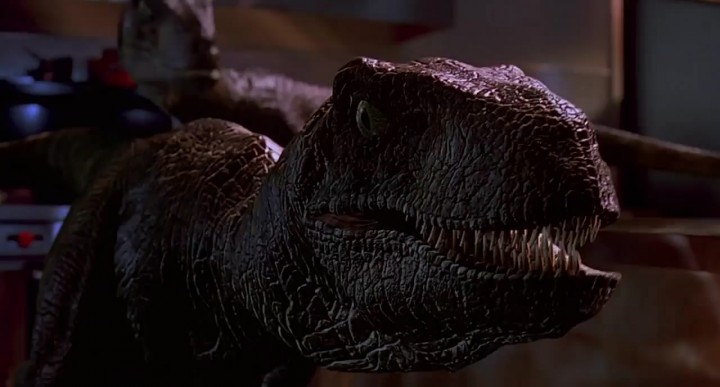 I guess it’s fair to say that Jurassic Park, much like Jaws, Indiana Jones and Star Wars before it, revolutionised cinema forever. Since Jurassic Park, more and more films have been released utilising the new digital power of computer technology to tell their story; often for good (The Matrix) and sometimes for bad (Star Wars Prequels). Digital effects have since all but replaced practical effects for speed, ease and creative control in film, and love them of hate them, those bytes of data in film will be around for a long time to come. As the progenitor of the digital effect event film, Jurassic Park remains and enduring masterpiece; it’s flawed certainly, but it’s effect can still be felt in every frame of modern films, from colour correction technology, to new sound technology, to bang-for-buck money shots like Cameron’s Avatar and Jackson’s Rings trilogy.
I guess it’s fair to say that Jurassic Park, much like Jaws, Indiana Jones and Star Wars before it, revolutionised cinema forever. Since Jurassic Park, more and more films have been released utilising the new digital power of computer technology to tell their story; often for good (The Matrix) and sometimes for bad (Star Wars Prequels). Digital effects have since all but replaced practical effects for speed, ease and creative control in film, and love them of hate them, those bytes of data in film will be around for a long time to come. As the progenitor of the digital effect event film, Jurassic Park remains and enduring masterpiece; it’s flawed certainly, but it’s effect can still be felt in every frame of modern films, from colour correction technology, to new sound technology, to bang-for-buck money shots like Cameron’s Avatar and Jackson’s Rings trilogy.


